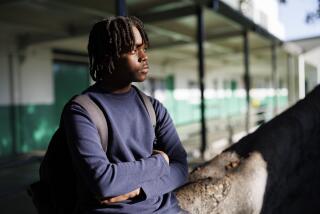Disabled Child’s School Experience Doesn’t Make Grade, Parents Say : New York: Alba entered regular classroom after her twin sister pleaded her case with President Clinton. But now family accuses district of dumping her in the mainstream without special help.
- Share via
NEW YORK — It was a touching moment--Anastasia Somoza, looking up from her wheelchair at the White House to plead that her more severely disabled twin, Alba, be allowed to attend regular school.
President Clinton’s eyes filled with tears. And her wish, expressed at a town meeting last year, was soon granted.
But this fairy tale and its 10-year-old heroines have not found a happy ending. Alba’s parents contend she was “dumped” into the regular classroom without the help she needs to succeed.
Her mother, Mary Somoza, promotes a concept called “inclusion”: allowing children, whatever the nature of their handicap, to spend their entire day in a regular classroom, with special services brought to them.
The family contends that the city’s Board of Education has violated Alba’s civil rights. Somoza attorney Salem Katsh says the law requires “every effort” to include disabled children in regular classrooms, with whatever special help they might need.
Katsh said the Somozas are “asking for compensatory services: special tutoring, special training for communications, an outside consultant to monitor the board’s compliance with relief. We are asking for a motorized wheelchair . . . to prevent fatigue.”
“For too long, these children were shunted aside,” agreed Larry Becker, attorney for the city Board of Education.
But he argues that inclusion is “a theory, not a legal mandate. Federal law says handicapped children should be educated in “the least restrictive environment”--and “least restrictive,” Becker says, should not always mean “regular classroom.”
The Board of Education is holding hearings on the case; no ruling is expected until later this month, at the earliest.
In the meantime, the Somozas contend that the schools continue to fail their daughter, as they have failed her since she was five years old.
The Somoza girls are great-granddaughters of Nicaraguan dictator Anastasio Somoza, who was assassinated in 1956. One of his sons, Anastasio, the girls’ great-uncle, was overthrown by the Sandinistas in 1979.
Anastasia and Alba have cerebral palsy. Anastasia, who has a milder form of the disease, speaks clearly--at times eloquently--and has attended regular classes from the start.
Alba, a quadriplegic, cannot speak but communicates with nods, moans, and glances toward symbols on a “communication board.” Experts say both sisters have above-average IQs.
Luanna Meyer, a special education expert from Syracuse University who testified for the family at the hearing, said that Alba “understands virtually everything said to her in English and Spanish.”
“She laughs at a joke, frowns or nods her head appropriately,” said Meyer. Despite her physical limitations, Alba “is a very bright little girl. . . . With today’s technology, she could become a rocket scientist.”
Mary Somoza said Alba functioned at normal grade level after preschool. But “when she started public school, year after year she regressed.”
She was placed in a special education class with one teacher and 15 students who included the learning disabled, the emotionally disturbed and those with speech or physical impairments.
Her individual education plan, said Mary Somoza, was poorly coordinated and “inadequately written.”
During the years she was “in segregated classrooms, she didn’t receive any education,” Katsh contends.
Last June, four months after Anastasia’s chat with the President, the school system decided to allow Alba into a regular fourth-grade class at Public School 234 in Manhattan.
The family says the school system merely responded to the publicity with “window dressing”--”dumping” Alba into the classroom without necessary support services.
Does she like her new class? Alba answered yes “with a smiling face,” said Anastasia, who often acts as her sister’s interpreter.
“Socially, of course, she’s better off,” said Mary Somoza. But “academically, it’s the same.”
Mary Somoza estimates that, despite her intelligence, Alba is doing schoolwork at only the first- or second-grade level.
Said Meyer: “There seems to have been a judgment that she wasn’t able to learn certain things, such as literacy.”
Not surprisingly, the Board of Education’s lawyer disagrees with any suggestion that the schools are at fault.
“We don’t think it’s dumping when you plan for the child’s enrollment, plan for a special teacher, for integrated therapy in the classroom, for communication devices and a communication specialist,” Becker said.
He said a special education teacher works with both Alba and her classroom teacher. The curriculum has been adapted for Alba. An aide helps her with health needs. And an occupational therapist, physical therapist and communication specialist are at her service.
Becker said the board is fulfilling its legal requirements toward Alba. He doesn’t fault her parents for going to bat for her, but contends, “To do more might be detrimental to the rest of the children in the class.”
“The school, overall, is excellent with a very warm and sensitive and caring staff,” said Becker. “They’ve really done a tremendous effort to provide Alba with an appropriate setting.”
But not enough, says Alba’s mother.
“There has to be curriculum planning, team efforts. . . . There has to be staff development,” said Mary Somoza. “We’re not saying the teachers are bad. They just don’t know because they haven’t been trained.”
More to Read
Sign up for Essential California
The most important California stories and recommendations in your inbox every morning.
You may occasionally receive promotional content from the Los Angeles Times.













